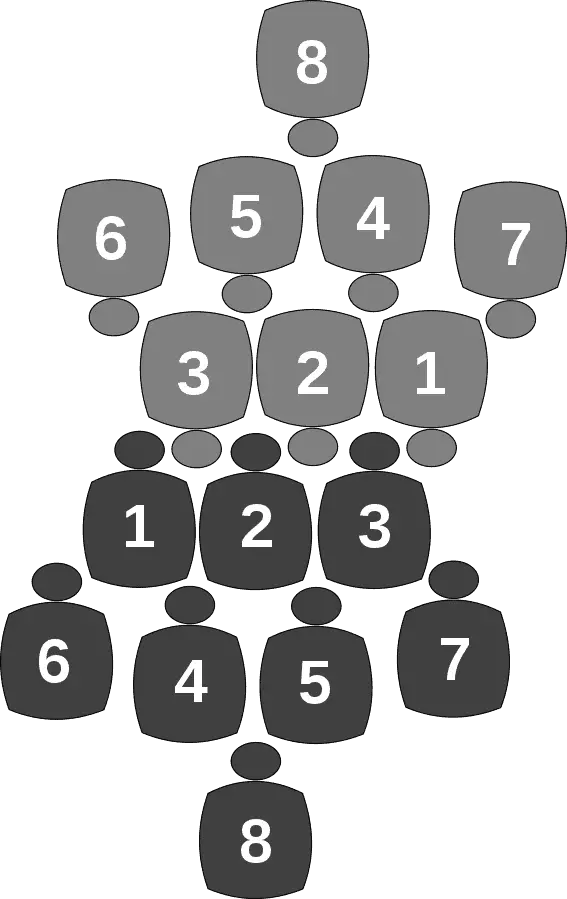A scrum is a way of restarting the game with a contest for the ball usually following: a knock on, a forward pass, a lineout throw that is not straight, when the ball gets stuck in a ruck or maul, or as a choice following a free-kick or penalty amongst other reasons.
Scrums are formed with eight players from either side that bind together in the correct formation with three front row players: two props and a hooker, two second rows, two flankers and a number 8.
The referee indicates where the scrum will take place by making a line with his foot across the pitch and the two sides bind either side of this mark facing squarely forward. Once players are bound with their own teammates correctly the opposition front rows should be no more than arms length apart.
Rugby scrum calls ‘Crouch, Bind, Set’
Here are the referees calls in full and what should be happening at each stage.
Crouch
The referee says ‘crouch’ and the front row players should crouch, but the head and shoulders are not allowed to go lower than the hips.
Each member of the front rows head, will slot to the left of the opponents in the front row opposite them so they position them accordingly ready to do this but don’t make contact yet.
Bind
Next, the referee says ‘bind’ and the props will use their outside free arm to bind on the opposition prop’s upper arm usually by grabbing hold of the jersey in some fashion. This bind should remain firm for the entirety of the scrum.
Set
If both sides of the scrum are steady and stable then the referee will call ‘engage’. At this point, the front row thrust their heads horizontally so that they interlock with the opposition’s front row.
All players must remain bound to the scrum throughout, players may push directly forward but not try to ‘wheel’ the scrum one way or the other, they may not deliberately try to collapse the scrum by pulling it down and they should not allow their head to pop up out of the scrum as a penalty will then follow.
- “Crouch, Bind, Set” – 2013 onwards
- “Crouch, Touch, Set” – 2012-2013
- “Crouch, Touch, Pause, Engage” 2007-2012
- “Crouch And Hold, Engage” 1990s-2007
- Pre 1990s – Regional variations/non standardised
The scrum-half will put the ball in normally from the left-hand side of the scrum. They may stand so that their left foot is at the middle point of the scrum meaning that they will put the ball in under the noses of their own front row.
The hooker may then use the heel of either foot to ‘strike’ for the ball, they must not use two feet at the same time.
After the ball arrives at the feet of the number 8, if the scrum is moving forwards or backwards they may keep the ball in the scrum with their feet, however, if the scrum remains stationary for 5 seconds then they must use the ball, i.e. the scrum half passes it away, the number 8 picks up, or the scrum half kicks it.
Pictured, correct binding positions in the scrum:

Suggested reading: Rugby Hand Off Rules Explained and a really good video explaining how to scrum from BT Sport and former international player Martin Bayfield.
What causes a penalty in a scrum?
Players are not allowed to deliberately collapse a scrum, wheel a scrum, or bore into the opposing team’s hooker. Teams sometimes commit these offences in order to prevent the opposition from dominating their scrum and pushing them backwards.
Often a team would rather give away the penalty and collapse the scrum rather than go backwards. By going backwards it uts the idea into the referees head that they have the weaker scrum and can impact the referees future decisions.
In other words it can cause the referee to penalise them more later in the game if they believe they have the weaker scrum. If that is the case then the other team can then deliberately drop the scrum and wrongfully gain a penalty for it. In this manner the scrum can turn into a bit of a game with the referee.
Take a look at this fine selection of scrum penalties, just beautiful!
Recommended reading: Penalties And Free Kicks In Rugby A Basic Guide
Does the ball have to go in straight in a scrum?
The scrum half has to put the ball into the scrum straight, however, they do not have to put the ball in directly down the middle line of the scrum. This is because they can stand with one shoulder aligned to the middle line of the scrum meaning they will put the ball in slightly on their own team’s side but still straight.
That said, in reality scrum halves do not put the ball in straight, they normally give the ball a slight angle towards their own side. The reason they do not penalise a non straight ‘feed/put-in’ is to allow the game to keep flowing.
The annoyance starts to build, however, if the referee allows one side to put the ball in not straight and not the other.
Side note forwards in the scrum are more likely to get injured than backs, check out: What Does Rugby Insurance Cover?
How many scrums per game are there?
In the 2019 Rugby World Cup there were on average 14 scrums per game, down from 32 in the inaugural world cup in 1987. This is due to various law changes introduced by World Rugby in an attempt to increase ball in play time and entertainment value for fans.
| World Cup | Scrum per game | Lineouts per game | Lineout win % | Ball in play time |
| 1987 | 32 | 45 | 68% | 28.11 |
| 1991 | 31 | 39 | 69% | 25.12 |
| 1995 | 23 | 37 | 73% | 26.43 |
| 1999 | 22 | 31 | 82% | 30.43 |
| 2003 | 22 | 34 | 80% | 31.58 |
| 2007 | 19 | 31 | 81% | 35.12 |
| 2011 | 17 | 24 | 82% | 32.12 |
| 2015 | 13 | 26 | 87% | 33.32 |
| 2019 | 14 | 25 | 91% | 34.21 |
How long does a scrum last in rugby?
Scrums can last from anywhere between 10 seconds if the hooker’s heel strike is clean, through to 2 minutes if the scrum needs resetting. The average length of a scrum is approximately 70 seconds.
These numbers are based on a study of the Saracens versus Munster game in 2019 where there were 17 scrums that in total lasted 1258 seconds, or just under 21 minutes. Most games contain between 12-20 scrums but there can be as many 30, or even single-digit numbers (source).
World Rugby, the governing body if the game is working hard to get scrum time down but there is no danger of it being turned into a lean to ‘rugby league’ style scrum. Real scrums where players push are an integral part of the game. Beside, what would all us fatties do on a Saturday afternoon!
Discover about red cards here: Rugby’s Red Cards Explained (Kyle Sinkler Examples)
Who has the best scrum in rugby?
Traditionally, South Africa, Argentina and England have had the best scrums in rugby. Georgia also takes great pride in their immense scrummaging ability. However, all tier-one playing nations have had periods where they have enjoyed a dominant scrum.
South Africa became world champions for the third time in 2019 when they beat England in the world cup final in Tokyo by 32-12. One of the main reasons that they won so comfortably was their powerful scrum.
It was clear from the first scrum of the game that England were going to struggle in this area and indeed they did, conceding a series of penalties throughout the game which allowed South Africa to kick down the touchline and gain a lot of territory as well as gather penalty points from kicks at goal.
South Africa also employ a rather unique tactic of bringing on an entire new front row of players for the second half of matches who are all as good if not better than the players starting the game. Bringing on fresh players of such quality is incredibly difficult to compete against even for teams as well resourced as England.
Suggested reading: Can you play rugby on an artificial pitch?
What is the point of a rugby scrum?
The point of a rugby scrum is to restart the game in a contestable way. It also draws all the forwards into one area of the pitch automatically creating space elsewhere for other players to run in to.
Recommended for you: The Basic Rules of The Lineout and How They Work And Rugby Mauls Explained: A Basic Guide
Image Credits
Diagram of rugby union scrum in 3-4-1 formation Shudde, Public domain, via Wikimedia Commons
